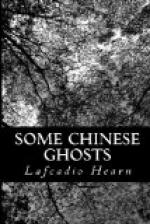YAO.—“Porcelain.” The reader who desires detailed information respecting the technology, history, or legends of Chinese porcelain-manufacture should consult Stanislas Julien’s admirable “Histoire de la Porcelaine Chinoise” (Paris, 1856). With some trifling exceptions, the names of the various porcelains cited in my “Tale of the Porcelain-God” were selected from Julien’s work. Though oddly musical and otherwise attractive in Chinese, these names lose interest by translation. The majority of them merely refer to centres of manufacture or famous potteries: Chou-yao, “porcelains of Chou”; Hong-tcheou-yao, “porcelains of Hong-tcheou”; Jou-yao, “porcelains of Jou-tcheou”; Ting-yao, “porcelains of Ting-tcheou”; Ko-yao,” porcelains of the Elder Brother [Thsang]”; Khang-hi-nien-t’sang-yao, “porcelains of Thsang made in the reign of Khang-hi.” Some porcelains were distinguished by the names of dynasties, or the titles of civic office holders; such as the celebrated Tch’ai-yao, “the porcelains of Tch’ai” (which was the name of the family of the Emperor Chi-tsong); and the Kouan-yao, or “Porcelains of Magistrates.” Much more rarely the names refer directly to the material or artistic peculiarity of porcelains,—as Ou-ni-yao, the “black-paste porcelains,” or Pi-se-yao, the “porcelains of hidden color.” The word khi, sometimes substituted for yao in these compound names, means “vases”; as Jou-khi, “vases of Jou-tcheou”; Kouan-khi, “vases for Magistrates.”
[Illustration: Chinese calligraphy]



